Curtiss P-40E Warhawk
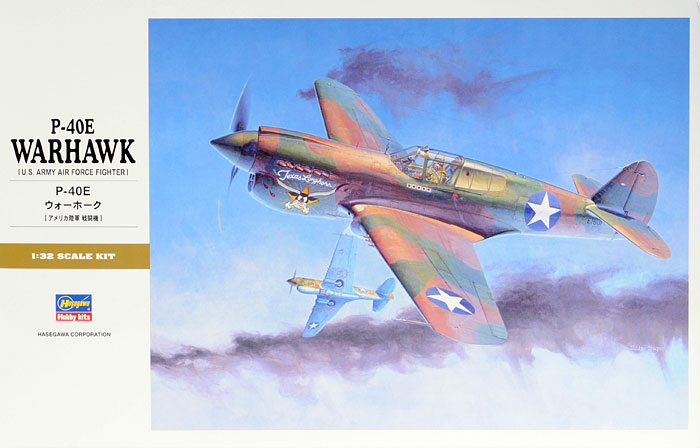
Hasegawa, 1/32 scale
S
u m m a r y |
| Catalogue Number: |
Hasegawa kit number ST29 - P-40E Warhawk |
| Scale: |
1/32 |
| Contents and Media: |
180 parts in grey plastic; 23 parts in clear plastic; four polythene caps; decals for two marking options. |
| Price: |
4,600 Yen (around USD$42.63) available online from HobbyLink Japan |
| Review Type: |
FirstLook |
| Advantages: |
Excellent and restrained surface features; very high level of detail (especially the cockpit); clever breakdown of clear parts will improve fit & miminise the risk of smearing glue on canopy; different parts supplied for open and closed canopy sliding section; options including different mirrors, avionics fit, pilot, bomb and drop tank. |
| Disadvantages: |
Extra diagonal frame on windscreen; inserts for different versions mean that extra care and time will be needed to align parts and for filling/sanding. |
| Recommendation: |
Highly Recommended |
Reviewed by
Brett Green

Hasegawa's 1/32 scale P-40E Warhawk is available online from HobbyLink Japan
Hasegawa's brand-new 1/32 scale P-40E Warhawk comprises 180 parts in grey styrene, 23 parts in clear and four polythene caps.
Surface detail is by way of crisply engraved panel lines supplemented with selected rows of recessed rivets , some raised rivets (behind the rear quarter windows) and raised fabric detail on control surfaces. The combined effect of these surface features is outstanding - the equal to some of Hasegawa's best work in this area to date.
The cockpits in Hasegawa's new generation of 1/32 scale kits have all been good, but in my opinion this is their best effort yet. Detail is deep and convincing on the sidewalls in particular. The seat looks great too. I was particularly pleased to see the oft neglected canopy rails moulded prominently to the cockpit opening.
The photo below shows my kit's cockpit just before it was installed in the fuselage. The only non-standard items used here are RB harnesses and some cockpit placard decals from Reheat.
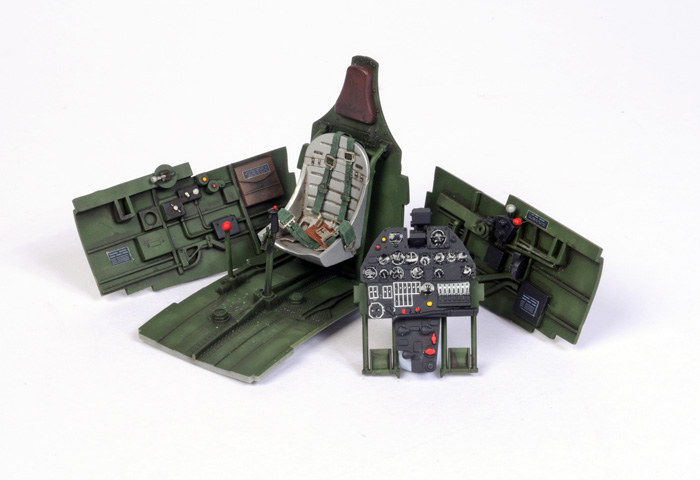
The kit supplies the separate underwing gun camera fairing, lower fuselage fuel dump, the fin attachment plate for the aerial wire, spine navigation light, a selection of different rear-view mirrors for the windscreen plus a ring and bead gunsight - all evidence of Hasegawa's careful attention to detail. Extra effort has also been applied to the design of the pitot tube.
The tubular exhausts are supplied in sections of two stubs each, which are simply glued on from the outside. Some P-40Es may have been retrofitted with the later fishtail exhausts (not supplied), so check your references carefully. The muzzles for the six .50 calibre machine guns are hollowed out - a nice touch.
Lower cowl flaps are moulded in the open position, and incorporate four small actuators. The radiator assembly includes rear face detail which will be visible beyond the open flaps.
The rudder is a separate part.
The undercarriage legs and wheels are very well done, and the wheel wells do feature the characteristic lightening holes in the spars.
Navigation and formation lights are moulded onto the grey plastic, but alternative clear parts are supplied if the modeller prefers. If this option is chosen, the moulded lights will have to be carefully sliced off the fin and wings, and replaced with the tiny clear parts.
The canopy is supplied in four thin, distortion free parts.
The windscreen features an additional diagonal frame on each side, similar to (but not the same as) the frame on the post side of the P-40N windscreen. Ideally, this should be scraped, sanded and polished off each side prior to assembly. I have actually done this myself, and will document the process in more detail in the full construction article.
There are two different sliding sections supplied. One is designed for a closed canopy (with the small triangular fairing cut out at the front), and the second will ride over the spine in the opne position. This is a nice feature that I hope we will see in all future Hasegawa kits featuring sliding canopies. The rear side windows are moulded as parts of a lager clear arch. I do like this approach, as it eliminates the tricky task of fairing in the edges of the clear window.
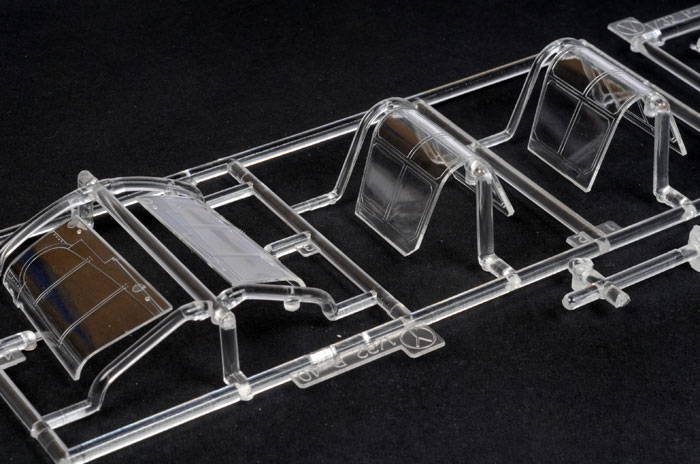
Apart from the optional wheel hubs, the kit also offers a drop tank, a 500lb bomb (both with their specific mounts and sway braces), two styles of antenna mast, two styles of pitot tube, three types of gun sight, a DF loop and a DF football.
Kit engineering is the only wrinkle in the ointment. Hasegawa clearly wants to release a large number of 1/32 scale Warhawk/Kittyhawk variants, but they also want to maximize the use of a single set of moulds. They have achieved both of these objectives by the use of inserts. The kit fuselage, in particular, is broken up according to the features of other variants. For example, this P-40E kit has a blank rectangular insert on each side the forward fuselage to allow for a vent in the same position on P-40M and N aircraft. There is a large insert for the mid upper fuselage to permit a later release with the arched perspex rear canopy section. The entire tail is a separate sub-assembly to so that the filleted fin of late P-40Es and the P-40K or long-tailed P-40Ms and Ns may be offered in future. Similarly, each set of three wing machine guns are plugged into the front of the wing's leading edge.
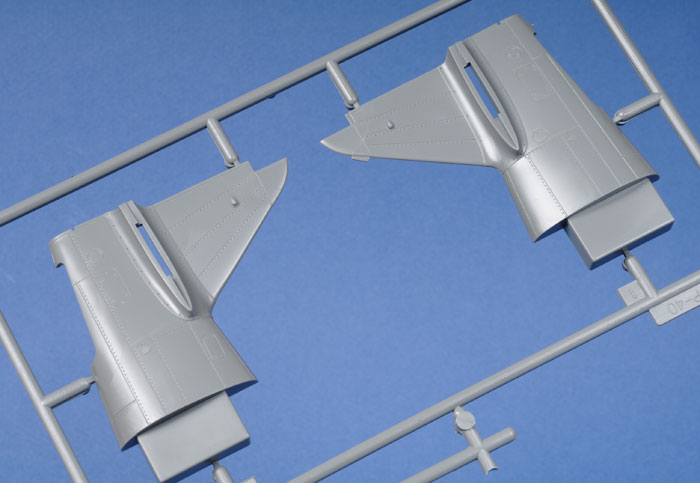
Now, this is good news for later variants, but it does potentially compromise fit and complicate construction. The biggest complaint is that none of these inserts fall on natural panel lines, so filling and sanding of all the join lines will be mandatory for a completely accurate result. I am already well into construction of the model, and I can confirm that some filling and sanding has been necessary.
It is pleasing to see that the fuselage and wings are structurally reinforced in the areas where the inserts are to be installed, improving the chances for accurate alignment.
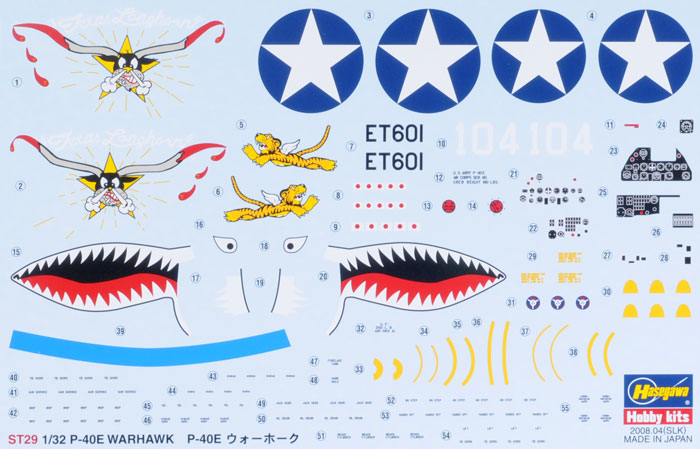
Markings are supplied for two US aircraft:
-
"Texas Longhorn" of the 9th FS, 49th FG in New Guinea, 1942
-
a shark-mouthed "Flying Tiger" flown by Major Edward Rector or the 76th FS, 23rd FG, China, July 1942.
In my opinion, Hasegawa's new 1/32 scale Warhawk is the best P-40 variant released in any scale to date, even taking into account the use of inserts and the mysterious extra windscreen frame. It is very similar in parts breakdown to Hasegawa's 1/48 scale kit, but brings several improvements to the table - most notably the cockpit sidewalls.
Surface features are well thought out, the cockpit is one of Hasegawa's best efforts, and the attention to detail is outstanding.
This is an excellent kit of an important subject. Take your time with alignment, filling and sanding and you will have a very impressive replica on your model shelf.
Highly Recommended.
Thanks to HobbyLink Japan for the sample
Review Text Copyright © 2008 by
Brett Green
Page Created 15 June, 2008
Last updated 15 June, 2008
Back to HyperScale Main Page
Back to Reviews Page |
Home
| What's New |
Features |
Gallery |
Reviews |
Reference |
Forum |
Search